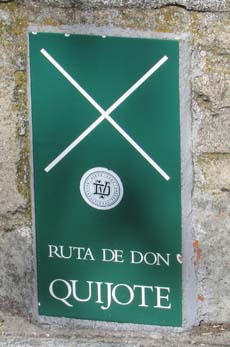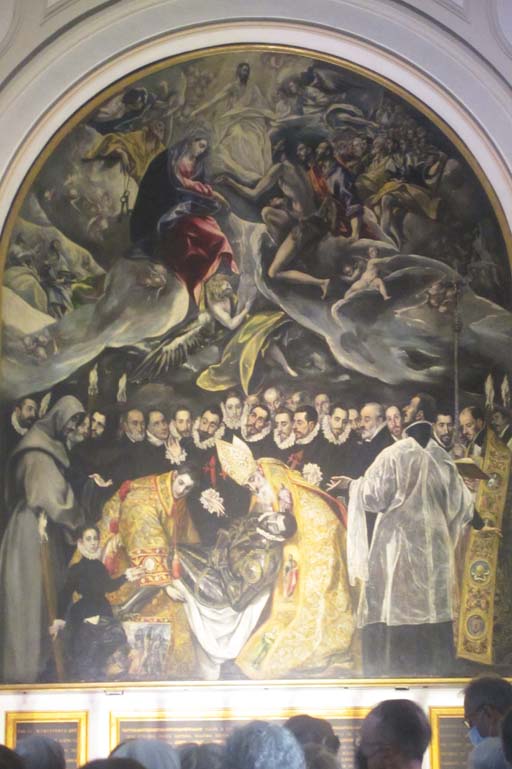Our last full day in Spain. We were scheduled to fly out of Madrid the next morning, and we already had hotel reservations in the capital.
It had been a kaleidoscopic journey, dashing from one corner of Iberia to another, like a butterfly dancing from one flower to the next. It was necessarily a bit superficial, but I hope that what we lost in depth we gained in breadth. I would happily have spent a week in nearly all the cities we visited, and maybe next time I will.
I was fairly astonished that we got to Spain in the first place. I was sure COVID would force cancellation of the trip. If I’d had more confidence that I was actually going to see Spain, I would at least have brushed up on my Spanish.
The drive from Granada toward Madrid took us through arid La Mancha, which still retains a few of its windmills. Much of the country is covered with olive trees, which are planted everywhere, including on steep bits of terrain on which I doubt I could find secure footing. I can’t imagine how they harvest anything from those trees, unless it’s by falling on them and knocking the fruit down the slope.
The city of Toledo was conveniently en route to Madrid, and from the road we had one spectacular view after another of the city on its hill with its walls, churches, narrow streets, and the river Tagus guarding the city on three sides. It was very defensible, which was why it became the principal capital of Castile (there was no one single capital).
In the States, the phrase “Holy Toledo!” is a quaint, rather old-fashion expression of surprise. Toledo is in fact holy-ish, insofar as it’s the seat of Spain’s archbishop, and has been since the Visigothic kingdom. (The Visigothic bishops seemed fond of <1> building valuable libraries, and <2> persecuting Jews.) The Bishops of Toledo apparently held on during the couple hundred years of Moorish rule, and emerged into full glory with the Reconquista. They were so powerful and so intrusive that Philip II established the new capital at Madrid in part to put some distance between himself and the commands the Church felt free to give him.
Toledo is a center of iron and steel production, and has been since Carthaginian times. Handmade iron door knockers, studs, and iron ornaments are common on door and walls. Swords of Toledo steel were treasured during the Middle Ages, and I have a Toledo broadsword, custom made to my own design, on display in my library. We went to one foundry— I think because it was close to the highway— and I found the experience mixed. They advertised Damascus steel but I didn’t see a single Damascened blade. (They did have the complete set of Game of Thrones blades.) Some of the swords and knives were very nice, but I already have nice swords and knives. They seemed critically understaffed and weren’t interested in waiting on me, and they lost a sale or two on that account. Some of the steel-and-gold jewelry they offered was really lovely, and I told Kathy that she was forgiven in advance if she bought some, but she decided she already has more jewelry than she can wear.
I bought a pocket watch with gold-and-steel inlay. I like pocket watches, but usually the lovely case contains works that are absolute rubbish, and I have a lot of dead pocket watches as a result. My fears were borne out when the watch died about two hours after I purchased it— fortunately it was just a dead battery.
Terry pointed out a knife of a type used in Spain to slice ham— you get your ham in paper-thin slices, and there are ham-slicing competitions. I was sufficiently in love with Spanish ham to think about ordering one— the top of the line is only $1300 or so— and so I purchased the knife to slice it with. (Haven’t ordered the ham yet, though.)
Defensible Toledo is built on a steep hill, and the government very kindly saved us the trouble of trudging up the acropolis by building a series of escalators that take you to the top. This was terrific, except that at the top everyone stepped off the escalator and just stood around while working out where to go next. I saw this crowd ahead of me, and lots more people coming up the escalator behind, and so I grabbed Jim— who is somewhat smaller than me— and used him as a battering ram to clear the way while I shouted “Move! Move!” The roadblock disintegrated.
Thank God I was there! Someone might have been hurt!
During their time in the city, the Moors continued the Visigothic traditions of killing Jews and building up valuable libraries, and Alfonso VI of Castile captured the city in 1085 with its libraries intact. He set up a large network of Arab and Jewish scholars to translate the books into Spanish, and then another group of scholars to translate the Spanish versions into Latin, thus rediscovering much knowledge that had been lost to Europe.
Four hundred years later came Ferdinand and Ysabel, who said adios to the Jews and Muslims. These left their architecture behind, and the Muslim quarter still retains its distinctive arches, and the Jewish quarter has the wrought-iron balconies used in the festival of Sukkot. The Jewish presence has been cleverly and subversively memorialized. You can be walking along the streets and see a little inset tile of a menorah, or some other probably-Jewish symbol set amid the cobblestones. Now that it won’t get them killed, there are shops offering Jewish memorabilia and souvenirs.
(There seems to be a consistent motif in many of the cities we visited that runs: “everyone lived in peace and harmony until they decided to kill the Jews.” I think the “peace and harmony” is somewhat exaggerated, especially in a place like Toledo, which was the scene of one battle, revolution, coup, or massacre after another for hundreds of years— though it has to be said they were pretty consistent about killing Jews.)
Toledo is chock-full of buildings of interest, of which we could see only a very few in one afternoon. There are tons of churches, monasteries, nunneries, and the large administrative buildings that run the archbishopric. We took time out to see the Synagogue of Santa Maria la Blanca, which is a 12th Century synagogue built in the Moorish style, by Moorish architects, for the Jewish community. It’s the oldest surviving synagogue in Europe. It has no women’s gallery, because at that time women weren’t expected to go to synagogue, and if they did they sat with the men. There is a lovely golden scallop-shaped alcove where the Torah ark would have been.
The synagogue became a Christian church in the 15th century, allegedly because a Dominican preacher converted 25,000 Jews at one stroke. (Christian mobs destroyed most of the town’s other synagogues.) Santa Maria is still owned by the Church, but is used as a museum.
We also visited the Church of Santo Tomé to view El Greco’s The Burial of the Count of Orgaz (1586), which recounts a miracle allegedly occurring in 1323, when a couple of saints turned up for the burial of the murdered mayor of Orgaz. It’s a rather complicated painting, with the burial in the lower half (witnessed by important citizens of 16th Century Toledo), and in the upper half the mayor’s wispy spirit being assisted to paradise by angels. If you find yourself wanting to know more, click the link.
Domḗnikos Theotokópoulos, who the Spaniards understandably prefer to call El Greco, was a resident of Toledo, and his old house is now a museum, with painting by Domḗnikos and several of his contemporaries. We didn’t have time to visit, alas, because we had to be in Madrid in time to have our fast Covid tests. We crossed the Tagus via the magnificent old Puente de San Martín, and went on to Madrid. The tests were negative, and we could fly home.
Next morning was the final glorious hotel buffet, then transport to the airport. I wish I’d had a briefing on what to expect in the airport, because guards insisted on proof of an airplane reservation before allowing me to even enter the airport. Apparently you’re supposed to use an app, but I didn’t have one. I had documents, but they were packed away in my bags.
The guards were quite cranky, I’m thinking because they were as annoyed at having to enforce the bullshit rule as I was at being the rule’s victim.
I knew that if I could just get to the American Airline desk, I’d be able to brandish my ID and get a boarding pass, but I didn’t have a boarding pass on me. Fortunately Kathy was able to find her reservations on her phone, and got me through by saying “He’s with me.” It probably helped that I looked very much like a middle-aged American tourist.
The Madrid airport is vast, and there were several kilometers of corridors, stairs, and security checkpoints before we found our gate. Along the way I played my favorite travel game of “buying nothing at Duty Free.”
Something about the journey home after a long trip has a psychological effect on me— my memories of the trip become dreamlike and unreal as I step back into my normal life. It’s almost as if the trip never happened. Viewing photos of the trip usually bring the journey back in its full reality— and one of the reasons I take so many pictures, and write these memoirs in such detail, is to keep the trip and its joys and discoveries alive in my own head.
As it turns out, I returned to my regular life hours before the plane landed in Albuquerque. On my computer I had the second-pass proofs of Lord Quillifer. They should have been sent to me in August, but somehow they weren’t, and they arrived hours before I was due to step on the plane to Spain.
Now, with fourteen hours in a steel tube trip ahead of me and nothing else to do, I applied myself to the proofs, and finished them before landing.
Damn. The things I do for my readers.





Welcome home! Thanks for sharing your adventures!
Hey, Mike! Where are you these days?
Comments on this entry are closed.